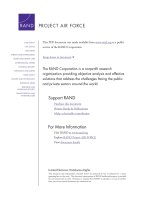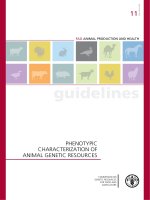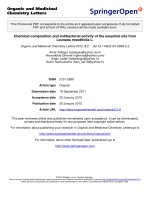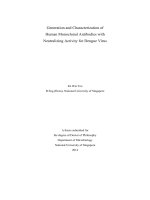Characterization of antibacterial activity of selected essential oils
Bạn đang xem bản rút gọn của tài liệu. Xem và tải ngay bản đầy đủ của tài liệu tại đây (295.02 KB, 9 trang )
Int.J.Curr.Microbiol.App.Sci (2019) 8(9): 1051-1059
International Journal of Current Microbiology and Applied Sciences
ISSN: 2319-7706 Volume 8 Number 09 (2019)
Journal homepage:
Original Research Article
/>
Characterization of Antibacterial Activity of Selected Essential Oils
Sujata Hota and Chandi C. Rath*
P. G. Department of Life Sciences, Rama Devi Women’s University,
Vidya Vihar, Bhubaneswar-751022, India
*Corresponding author
ABSTRACT
Keywords
Escherichia coli,
Staphylococcus
aureus,
Pseudomonas
aeruginosa,
Essential oils,
Minimum Inhibitory
Concentration (MIC)
Minimum Killing
Time (MKT)
Multiple Antibiotic
Resistance (MAR)
Article Info
Accepted:
14 August 2019
Available Online:
10 September 2019
In the present investigation, eleven essential oils (Curry Leaf, Ginger, Azowan,
Betel leaf, Black cumin, Marjoram, Hedychium, Calamus, Peppermint,
Cinnamon, Basil) were screened, in order to assess their antimicrobial
activities against three bacteria (Escherichia coli, Staphylococcus aureus and
Pseudomonas aeruginosa). Of the eleven essential oils studied, Azowan,
Peppermint, Basil, Black cumin and Cinnamon oils showed strong
antibacterial activity against the pathogens. The Minimum inhibitory
concentration (MIC) values of the oils, ranged between 0.48-125 μl/ml. The
Minimum Killing Time (MKT) of the oils varied from 0 to 60 mins, at room
temperature. The oils retained their antibacterial activities, even after heat
treatment (100°C for one hour), and on autoclaving which indicated the
presence of barostable and thermostable components in these oils. The phenol
co-efficient values of the oils fall between 0.25-0.5. The antibiotic sensitivity
pattern of the pathogens had shown multiple antibiotic resistance (MAR). The
activities of the oils reported to be bactericidal in nature, and were well
compared to the standard antibacterial compounds.
Introduction
Many bacterial and fungal pathogens have
evolved numerous defense mechanisms
against antimicrobial agents and showed
resistance to old and newly produced drugs.
For the last few decades, multi drug resistance
has become an increasing concern for both
gram positive and gram negative bacteria
(Brunel and Guery, 2017). The resistance of
the microorganisms increased due to over and
misuse of the commercial antimicrobial drugs
and chemotherapeutic agents as well as a lack
of new drug development by the
pharmaceutical industry (Gould and Bal,
2013; Viswanathan, 2014; Michael et al.,
2014).
This situation has forced the researchers and
academicians, to search for new antimicrobial
substances from various sources, foremost are
the medicinal and aromatic plants, as plant
1051
Int.J.Curr.Microbiol.App.Sci (2019) 8(9): 1051-1059
products are biodegradable, and without any
side effects to the animals and environment.
Several aromatic and medicinal plants produce
essential oils (EOs). EOs are hydrophobic
liquid, clear or unusually coloured, composed
of complex compounds that are volatile in
nature. They are characterised by strong odour
and obtained from medicinal and aromatic
plants part such as flowers, leaves, seeds,
bark, fruits and roots (Burt, 2004). EOs have
been reported to possess antifungal,
antibacterial, antiviral, antioxidant, analgesic
and anti- inflammatory activities (Gao et al.,
2011; Gilles et al., 2010; Kordali et al., 2005;
Mourey & Canillac, 2002; Prakash et al.,
2011). There is an dire need for newer
antimicrobial compounds, and EOs are less
studied. So, this prompted us to test the
antibacterial activity of some selected
essential oils against the bacterial pathogens
such as E.coli, S. aureus and P. aeruginosa.
Materials and Methods
Pathogens
and Cinnamon (Cinnamomum verum), Basil
(Ocimum basilicum) were procured from
Flower
and
Fragrance
development
cooperation, Berhampur, Odisha, were used to
assess their antimicrobial activities against the
test pathogens.
Media and Chemicals
Nutrient broth (NB), Nutrient agar (NA) and
Tween 80 were procured from Hi-Media Ltd.
Mumbai, India, and all the media were
prepared
according
to
manufacturer’s
instruction. The media were supplemented
with 0.75% of Tween 80 (T-80) to facilitate
the miscibility of the oils.
Preliminary screening of oils by Disc
Diffusion Method (DDM)
For the preliminary screening of the EOs, Disc
Diffusion Method (DDM) described by Bauer
et al., (1996) was used, to assess their
antimicrobial properties qualitatively.
Determination of the Minimum Inhibitory
concentration (MIC) of the oils
The test pathogens [Escherichia coli (MTCC1675), Staphylococcus aureus (MTCC-902),
and Pseudomonas aeruginosa (MTCC-741)]
were used in this study and were obtained
from P.G Department of Microbiology,
College of Basic Science and Humanities,
OUAT, Bhubaneswar.
Essential oils
Eleven different EOs viz., Curry Leaf
(Murraya koenigii), Azowan (Trachyspermum
ammi), Betel leaf (Piper betel), Black cumin
(Nigella sativa), Peppermint (Mentha piperita)
from Southern species, Madurai, Ginger
(Zingiber officinales), Marjoram (Origanum
marjorana),
Hedychium
(Hedychium
coronarium), Calamus (Acorus calamus) from
Hitesh Aromatics, Mandi, Himachal Pradesh,
Minimum Inhibitory Concentration of the oils
was determined by Tube Dilution Method
described by Rath et al., (1999), with slight
modification. In brief, NB was supplemented
with 0.75% Tween 80 and was dispensed into
test tubes and sterilized. By the help of sterile
pipette, 0.5ml of the oil was transferred to the
first test tube and mixed by vortexing for a
homogenous emulsion. Further, the sample
was serially diluted as two- fold dilution.
From the 10th test tube, 0.5ml of emulsion was
discarded. 20 μl of freshly grown culture was
added to all test tubes, and incubated at 37◦C
for 24 hrs. One tube without oil served as
control. A loop full of bacterial culture was
taken from each test tube, and then streaked
on the agar plates. Plates were incubated at
37◦C for 24 hrs. After the incubation period,
1052
Int.J.Curr.Microbiol.App.Sci (2019) 8(9): 1051-1059
the plates were observed for the bacterial
growth. No growth of the test organism at a
particular concentration was determined as
MIC for that oil.
Determination of the Minimum Killing
Time (MKT) of the oils
The Minimum Killing Time (MKT) of the oil
was described by Rath et al., (2005).
Overnight incubated NB cultures of
microorganisms were inoculated into NB
containing MIC level of the oils, and were
incubated at 37◦C. One tube without oil served
as Control. Under aseptic conditions, one loop
full of the sample from the test tubes was sub
cultured on to NA plates at 0ʹ, 2ʹ, 5ʹ, 10ʹ, 15ʹ,
30ʹ, 1hr, 2hrs, 3hrs, 4hrs and 5hrs of interval
and incubated at 37◦C for 24hrs. After
incubation, the plates were observed for
bacterial growth. No growth on sub-culturing
at the particular time, was regarded as the
minimum time required to kill the bacteria by
that oil.
Effect of temperature and pressure on
antibacterial activity of oils
An experiment was designed to study the
effect of high temperature (by treating the oils
at 100◦C for 1hr, in a boiling water bath) and
pressure (autoclaving the oils) on antibacterial
activity of the test oils by Disc Diffusion
Method. Sterile filter paper discs were
mounted on the surface of the pre-cultured
(from 24hrs old culture, swept on NA plates)
bacterial pathogens on agar plates at equal
distance. Subsequently, all the EOs were
heated at 100◦C for 1hr and autoclaved at
121◦C and 15 lbs pressure, for 20 mins.
Using a sterile pipette, EOs were loaded (at
MIC level) over the sterile filter paper discs
separately, and incubated at 37◦C for 24 hrs.
Plates were observed for zone of clearance
around the discs which indicates positive
antibacterial activity of the treated oils, in
comparison to control oil.
Determination of the Phenol Coefficient
value of the oils
Selective oils that had shown better
antibacterial properties, were subjected to
phenol coefficient test, in order to compare
their efficiency, described by Rath and
Mohapatra (2015).
Determination of drug sensitivity pattern of
test pathogens
An experiment was conducted, to study the
antibiogram as well as the multiple antibiotic
resistances (MAR %) pattern of the test
pathogens, in order to compare the
antibacterial activity of the EOs with standard
antibacterial drugs. The antibiogram pattern
was studied following the method of Bauer et
al., (1996). Standard antibiotic discs, procured
from Hi-Media, Mumbai were used in this
study. After the incubation period, plates were
observed for susceptibility (sensitivity of the
organism to an antibiotic) or resistance (no
zone of clearance around the disc) of the
pathogen towards a specific antibiotic. The
multiple antibiotic resistance % of the
pathogens was determined by using the
formula:
Number of antibiotics to
which the pathogen
Showed resistance
MAR= ----------------------------------Total no. of antibiotics used
Results and Discussion
The bioactivities of eleven EOs were
evaluated against three pathogens (E.coli, S.
aureus and P. aeruginosa). The EOs of
Azowan, Peppermint, Basil, Black cumin and
Cinnamon had shown strong antibacterial
activity, in terms of their zone sizes against
1053
Int.J.Curr.Microbiol.App.Sci (2019) 8(9): 1051-1059
the test pathogens (Table-1). The Zone of
Inhibition ranged from 8-32 mm. Azowan oil
had shown similar results against E.coli and S.
aureus (25 mm), respectively whereas,
showed zone size of 30 mm against P.
aeruginosa. The three test organisms were
resistant to Curry leaf oil. Resistance was too
observed in case of E.coli and S. aureus
against betel leaf and Calamus oil. The oils
differ in their antibacterial activities against
the test pathogens, in terms of Zone of
inhibition. In comparison to our observations,
Mekonnen et al., (2016) also reported that,
Trachyspermum schimperi had shown higher
zone sizes of 23.5 mm, 12 mm and 16 mm
against S. aureus, E.coli, and P. aeruginosa,
respectively.
Minimum Inhibitory Concentration (MIC)
values of four oils (Betel leaf, Cinnamon,
Marjoram and Peppermint) evaluated against
three test pathogens, ranged from 0.48-125
μl/ml (Table-2). Lowest MIC values of 0.97
µl/ml and 0.48 µl/ml were observed in case of
Cinnamon oil against E.coli and S. aureus,
respectively.
Highest MIC value of 125 μl/ml was observed
in case of peppermint against S. aureus. Oils
of Betel leaf and Marjoram had shown MIC
value of 62.5 µl/ml against S. aureus and P.
aeruginosa, respectively, whereas Cinnamon
oil showed similar MIC value of 62.5 µl/ml
against P. aeruginosa. In comparison to our
observations, Lv et al., (2011) also reported
lower MIC value (0.1-0.4 μl/ml) of Cinnamon
oil against S. aureus and E.coli. Generally,
higher MIC values observed against Gm-ve
bacteria in comparison to Gram+ve bacteria
could be attributable to the thick layer of
lipopolysaccharide (more resistant to EOs)
outer membrane covering the cell wall as
compared with the gram-positive bacteria
having homogenous peptidoglycan layer
structure (Salton, 1953; Sikkema, D et al.,
1995; Hsouna et al., 2011). In contrast, in our
studies, we observed higher MIC values of
EOs against S. aureus as compared to E.coli.
The activities of the EOs were observed to be
bactericidal, as no growth was recorded on
subculture onto NA plates from the MIC
dilution tubes. The Minimum Killing Time
(MKT) of the oils, varied from 0 to 60 mins, at
room temperature (Table-3). Oils of Betel leaf
killed both the pathogens (E.coli and S.
aureus) within 30 mins. Peppermint oil killed
E.coli and P. aeruginosa within 60 mins.
The oils of Marjoram and Cinnamon killed all
the three test pathogens within 0 min. Killing
of these pathogens immediately by these EOs
suggested that the oils cause an irreversible
damage to the cellular structure of the
pathogens, when they come in contact with the
oil mixture (Pattnaik et al., 1995; Rath et al.,
1999a, b, 2001, 2002 & 2005).
The tested oils had shown antibacterial
activity even after treating them at 100ºC for
an hour (in a boiling water bath), and
autoclaving (121ºC and 15 lb pressure for 20
mins) (Table-4).
In case of Marjoram and Peppermint oil, zone
size was highly decreased, when treated with
high pressure and temperature as compared to
normal untreated oil, against E.coli and S.
aureus. Betel leaf and Cinnamon oil when
treated with high temperature, the zone of
inhibition was same as that of untreated oil
against E.coli and S. aureus, respectively. All
the oils had shown decrease in the zone size
by boiling and autoclaving, against P.
aeruginosa, but the changes were not
remarkable. Observation of antibacterial
activity of the tested EOs even on heat
treatment and autoclaving, indicated the
presence of some thermostable and barostable
components in the oils. Rath et al., (2001)
observed decreased activity of turmeric leaf
and rhizome essential oils, against these
pathogens.
1054
Int.J.Curr.Microbiol.App.Sci (2019) 8(9): 1051-1059
Table.1 Antimicrobial activities of essential oils by using Disc Diffusion Method
Sl. no.
1.
2.
3.
4.
5.
6.
7.
8.
9.
10.
11.
Essential Oils
Curry leaf
Ginger
Azowan
Betel leaf
Black cumin
Marjoram
Hedychium
Calamus
Peppermint
Basil
Cinnamon
*R- Resistant
Zone of Inhibition (ZOI) in mm.
E.coli
S. aureus P. aeruginosa
R
R
R
12
11
20
25
25
30
R
R
20
12
20
32
10
14
10
8
R
14
R
R
10
11
10
25
24
18
23
24
10
20
Table.2 Minimum Inhibitory Concentration (MIC) of oils
Sl.no.
1.
2.
3.
Essential Oils
Betel leaf
Cinnamon
Marjoram
MIC VALUES (μl/ml)
Escherichia coli
Staphylococcus
aureus
7.81
62.5
0.97
0.48
31.25
62.5
Peppermint
3.9
4.
*R= Resistant to particular oil
125
Pseudomonas
aeruginosa
62.5
62.5
62.5
31.25
Table.3 Minimum Killing Time of essential oils against test pathogens
Sl.no. Essential Oils
MINIMUM KILLING TIME (MKT) AT 37◦C IN MINS
Escherichia coli
1.
2.
3.
4.
Betel leaf
Cinnamon
Marjoram
Peppermint
30mins
0min
0mins
60mins
1055
Staphylococcus
aureus
30mins
0min
0min
0min
Pseudomonas
aeruginosa
0min
0min
0min
60mins
Int.J.Curr.Microbiol.App.Sci (2019) 8(9): 1051-1059
Table.4 The effect of temperature and pressure on antibacterial activities of the oils
Essential
oils
Zones of Inhibition (in mm) at different temperatures
Betel leaf
UT
15
E.coli
100◦C
15
A
14
UT
12
S. aureus
100◦C
14
A
12
UT
12
P. aeruginosa
100◦C
A
2
9
Cinnamon
14
15
13
13
13
14
10
9
10
Marjoram
13
7
8
11
10
9
10
10
9
Peppermint
11
8
9
18
17
16
7
9
R
UT- Untreated i. e oils were tested without heating or autoclaving, A: autoclaved oils, oils were applied at MIC
level on discs.
Table.5 Phenol Co-efficient value of essential oils
Essential oils
Phenol coefficient
Betel leaf
Marjoram
0.25
0.5
Peppermint
Cinnamon
0.5
0.25
Table.6 Antibiogram pattern of the test pathogens tested by DDM of Bauer et al., (1996)
PATHOGENS
ANTIBIOGRAM
Sensitive to
Escherichia coli
Staphylococcus
aureus
Pseudomonas
aeruginosa
Resistant to
MAR%
Co(18), Cq(13),GEN (18),
MET, AP, NS, P, 47.05%
AK(19), CE (22), C(31),
B, Lz, PB, Ax
S(18), NF(22), Do(20)
Co(21), Cq(21), GEN(21), MET, AP, NS, Lz, 29.41%
AK(21), CE(16), C(29), PB
S(21), NF(24), P(23),
B(15), Do(27), Ax(19)
Cq(13), GEN(17), Ak(19),
Co, MET, AP,NS, 52.94%
CE(22),
C(31),
Ax, P, B, Lz, PB
S(20), NF(22), Do(19)
The values in paranthes indicates zones of inhibition in mm
They reported that the viscosity of the oil
increased at higher temperature (1000C) which
could be an inhibiting factor in the
diffusibility of the oils over the plates and
results in smaller zones of inhibition. Das
(2008) and Das et al., (2009) reported the
antibacterial activity of EOs of three Ocimum
spp. and their cocktail mixture at high
temperature and pressure treatment. They
observed the presence of heat stable and baro
stable components in these oils, as reported in
our studies.
1056
Int.J.Curr.Microbiol.App.Sci (2019) 8(9): 1051-1059
The phenol co-efficient value of the four oils
tested, ranged from 0.25- 0.5 (Table-5).
Highest phenol co-efficient value (0.5) was
observed in case of Marjoram and Peppermint.
Betel leaf and Cinnamon oil had shown lowest
phenol co-efficient value of 0.25. Rath et al.,
(2008) reported that samples with lowest MIC
values had shown highest phenol coefficient
values which differs from our investigation.
The antibiogram pattern of the test pathogens
is presented in Table-6. From the antibiogram
pattern, all the organisms were resistant to
Methicillin,
Amphotericin-B,
Nystain,
Linezolid and Polymyxin-B, whereas, the
sensitivity pattern differs. The antibiotic
sensitivity pattern of the pathogens showed
multiple antibiotic resistance (MAR). Highest
MAR% was recorded in case of P. aeruginosa
(52.94%), followed by E.coli (47.05%) and S.
aureus (29.41%). The zone of inhibition
observed in case of the essential oils could be
well compared with standard antibiotics.
Smaller zone of inhibition by Eos with respect
to antibiotics used, could be attributable to the
crudeness of the active compound(s) present
in the tested EOs.
Senhaji et al., (2007) observed the
antibacterial activity of essential oil from
Cinnamum zeylanicum against E.coli 0157:H7
is through outer membrane disintegration and
increasing the permeability to ATP through
cytoplasmic membrane that corroborates with
the findings observed in this investigation as
E.coli was resistant to Penicillin and
Bacitracin. Similarly, Rath et al., (2005) also
reported the anti-staphylococcal activity of
Juniper and Lime essential oils against
methicillin resistant Staphylococcus aureus
(MRSA) through inhibition of cell membrane
synthesis. This corroborates with our
observations. Through this investigation we
have placed in record, the antibacterial activity
of the essential oils, is suggestive of their uses
in discovery of newer antimicrobial
compounds, and / or in pharmaceutical, aroma
and cosmetics industries with proper scientific
investigations.
References
Bauer, A. W., Kirby, W. M., Sherris, J. C.,
and Truck, M., 1996. America. J. Clin.
Pathol. 14 (17): 493-496.
Brunel, A. S., and Guery, B., 2017. Multidrug
resistant (or antimicrobial resistant)
pathogens – alternatives to new
antibiotics. Swiss Med Wkly. Nov 22;
147: w14553. DOI: 10.4414.
Burt, S., 2004. Essential oils: Their
antibacterial properties and potential
application in foods- a review. Int. J.
Food microbio. 94: 223-253.
Das, I., Tayung, K., Rath, C. C., and
Mohapatra, U. B., 2009. Antibacterial
assessment of essential oils of three
Ocimum spp. against food borne
pathogens. Plant Sci. Res. 31: 60-5.
Das, I., 2008. In vitro antimicrobial potential
assessment of essential oils of three
Ocimum spp. M. Phil thesis, North
Orissa University: 1 – 60.
Gao, C. Y., Tian, C. R., Lu, Y. H., Xu, J. G.,
Luo, J. Y., and Guo, X. P., 2011.
Essential
oil
composition
and
antimicrobial
activity
of
Sphallerocarpus gracilis seeds against
selected food-related bacteria. Food
Control. 22: 517–522.
Gilles, M., Zhao, J., An, M., and Agboola, S.,
2010. Chemical composition and
antimicrobial properties of essential
oils of three Australian Eucalyptus
species. Food Chemistry. 119: 731–
737.
Gould, I. M., and Bal, A. M., 2013. New
antibiotic agents in the pipeline and
how they can overcome microbial
resistance. Virulence: 4(2): 185–191.
Hsouna, A. B., Trigui, M., Mansour, R. B.,
Jarraya, R. M., Damak, M., and Jaoua,
1057
Int.J.Curr.Microbiol.App.Sci (2019) 8(9): 1051-1059
S., 2011. Chemical composition,
cytotoxicity effect and antimicrobial
activity of Ceratonia siliqua essential
oil with preservative effects against
Listeria inoculated in minced beef
meat. International Journal of Food
Microbiology. 148 (1): 66-72.
Kordali, S., Kotan, R., Mavi, A., Cakir, A.,
Ala, A., and Yildirim, A., 2005.
Determination of the chemical
composition and antioxidant activity of
the essential oil of Artemisia
dracunculus and of the antifungal and
antibacterial activities of Turkish
Artemisia
absinthium,
A.
drancunculus, Artemisia santonicum,
and Artemisia spicigera essential oils.
Journal of Agricultural and Food
Chemistry. 53: 9452–9458.
Lv, F., Liang, H., Yuan, Q., and Chunfang,
Li., 2011. In vitro antimicrobial effects
and mechanism of action of selected
plant essential oil combinations against
four food-related microorganisms.
Food Research International. 44:
3057–3064.
Mekonnen, A., Yitayew, B., Tesema, A., and
Tadesse,
S.,
2016.
In
vitro
Antimicrobial activity of Essential oil
of Thymus schimperi, Matricaria
chamomilla, Eucalyptus globulus and
Rosmarinus officinalis. Int. J. of
Microbiology. vol. 2016, Article ID
9545693,
8
pages,
doi:
10.1155/2016/9545693.
Michael, C. A., Dominey-Howes, D., and
Labbate, M., 2014. The antibiotic
resistance crisis: causes, consequences,
and management. Front Public Health.
2: 145.
Mourey, A., and Canillac, N., 2002. AntiListeria monocytogenes activity of
essential oils components of conifers.
Food Control. 13: 289–292.
Pattnaik, S., Suvramanyam, V. R., and Rath,
C. C., 1995. Effect of essential oils on
the viability and morphology of
Escherichia coli (SP-11). Microbios.
84: 195-9.
Prakash, B., Shukla, R., Singh, P., Mishra, P.
K., Dubey, N. K., and Kharwar, R. N.,
2011.
Efficacy
of
chemically
characterized Ocimum gratissimum L.
essential oil as an antioxidant and a
safe plant based antimicrobial against
fungal and aflatoxin B1 contamination
of spices. Food Research International.
44: 385–390.
Rath, C. C., Dash, S. K., Mishra, R. K. and
Charuyulu, JK., 1999a. In vitro
evaluation of antimycotic activity
turmeric (Curcuma longa L.) essential
oil against Candida albicans and
Cryptococcus neoformans. Ind. Perf.
43 (4): 172–178.
Rath, C. C., Dash, S. K., Mishra, R. K.,
Ramachandraiah, O. S., Azeemoddin
G., and Charuyulu, J. K., 1999b. A
note on the characterisation of
susceptibility of turmeric (Curcuma
longa) leaf oil against Shigella species.
Ind. Drugs. 36 (2): 133–136.
Rath, C. C., Dash, S. K. and Mishra, R. K.,
2001. In vitro susceptibility of
Japaneese mint leaf oil against five
human fungal pathogens. Indian
Perfumer: 45 (1): 57–61.
Rath, C. C., Dash, S. K., and Mishra, R. K.,
2002. Antifungal efficacy of six Indian
essential oils individually and in
combination. J. Essent. Oil Bearing Pl.
5: 99–107.
Rath, C. C., Mishra, S., Dash, S. K. and
Mishra,
R.
K.,
2005.
Antistaphylococcal activity of lime and
Juniper essential oils against MRSA.
Ind. Drugs. 42 (12): 797–801.
Rath, C. C., Devi, S., Dash S. K., and Mishra
R. K., 2008. Antibacterial potential
assessment of Jasmine essential oil
against E.coli. Indian J Pharm Sci.
Mar-Apr; 70(2): 238- 241.
1058
Int.J.Curr.Microbiol.App.Sci (2019) 8(9): 1051-1059
Rath,
C. C., Mohapatra, S., 2015.
Susceptibility
characterisation
of
Candida spp. to four essential oils.
Indian J. of Medical Microbiology.
vol. 33(5): s93 – 96.
Salton, M. R., 1953. Studies of the bacterial
cell wall: IV. The composition of the
cell walls of some gram-positive and
gram-negative bacteria. Biochimica et
Biophysica Acta. 10(4): 512-523.
Senhaji, O., Faid, M., and Kalalou, I., 2007.
Inactivation of Escherichia coli O157:
H7 by essential oil from Cinnamomum
zeylanicum. Braz J Infect Dis. 11: 2346.
Sikkema, J., de Bont, JA., and Poolman, B.,
1995. Mechanisms of membrane
toxicity of hydrocarbons. Microbiol
Rev. 59 (2): 201-22.
Viswanathan, V. K., 2014. Off-label abuse of
antibiotics by bacteria. Gut Microbes.
5(1): 3–4.
How to cite this article:
Sujata Hota and Chandi C. Rath 2019. Characterization of Antibacterial Activity of Selected
Essential Oils. Int.J.Curr.Microbiol.App.Sci. 8(09): 1051-1059.
doi: />
1059









